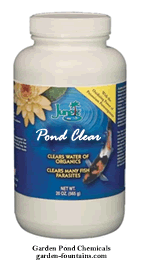 The number one concern for a pond is keep chlorine and chloramines out of your water! If your fountain is filled from your tap, it has these chemicals, small amounts not lethal to humans, but detrimental to your water garden. If you are just starting your pond, it is best to wait up to two weeks before implementing any type of fish into your pond.
The number one concern for a pond is keep chlorine and chloramines out of your water! If your fountain is filled from your tap, it has these chemicals, small amounts not lethal to humans, but detrimental to your water garden. If you are just starting your pond, it is best to wait up to two weeks before implementing any type of fish into your pond.
When adding water to a pond, if more that 10 percent of the current water volume, you may want to consider adding a chemical to quickly remove the chlorine and chloramines, especially if you already have fish in the pond. Make sure you are as exact as possible when measuring these chemicals, as they can also be harmful to your fish. Sodium thiosulfate is a great dechlorinator, and can be purchased in bulk. Make sure none of your chemicals contain Formalin; this will not reduce the chloramines, but create a sticky sludge that can cause your fish to stick!
You may consider these other factors that need chemical attention:
-removing algae
-balancing pH level
-fertilizers to increase your aquatic life
-reducing ammonia
Even though these factors have chemical components to care for them, there are natural elements as well that can be used. Algae will develop each spring, no matter what, but there are plants that can steal the nutrients from the water that feeds the algae. As you control the algae, it will help to control the pH balance. If it should drop below 7.0, the water will need treated. Fertilizers can be a pollutant themselves, as long as your plants receive lots of sunlight, food, and attention they will reach a good size on their own! Adding a beneficial bacteria will combat the ammonia, caused by waste from your aquatic life, there are also special filters the keep these compounds at bay.
